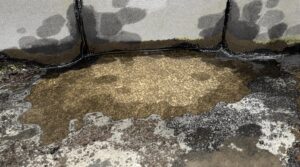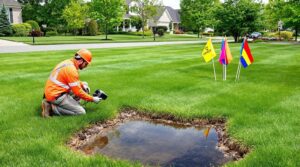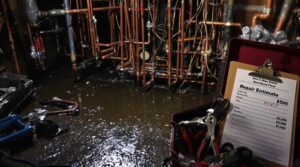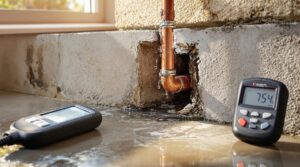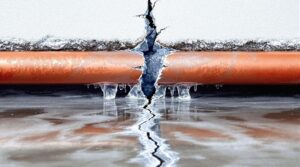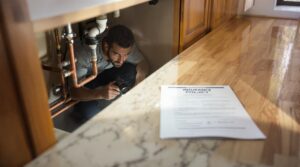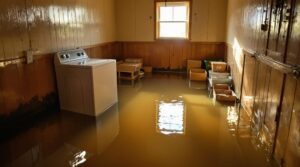Underground water lines require multiple layers of protection to prevent freezing. Professional installation should place pipes below the local frost line, typically 4-6 feet deep, with proper compacted backfill and drainage. Waterproof foam insulation wrapping, combined with self-regulating heat cables rated at 12 watts per foot or less, provides essential thermal protection. Regular professional inspections can identify vulnerabilities before winter damage occurs. Understanding additional preventive measures guarantees year-round system reliability.
Key Takeaways
- Install water lines below the local frost depth, typically between 4-6 feet underground depending on regional requirements.
- Wrap pipes with specialized foam insulation designed for underground use and protect with waterproof covering.
- Install self-regulating heat cables along vulnerable pipe sections, ensuring proper wattage for the pipe material.
- Use sand backfill around pipes to promote drainage and prevent moisture accumulation that could lead to freezing.
- Conduct regular professional inspections to verify insulation integrity and proper depth of water lines.
Understanding Frost Depth and Water Line Placement
Proper water line placement begins with a thorough understanding of frost depth in one's geographical location. Local building codes and guidelines specify minimum burial depth requirements for water service lines, which vary greatly by region. In areas like New York City, water lines must be installed 5 to 6 feet below ground level to guarantee protection against freezing.
Important factors in determining appropriate burial depth include the local climate patterns and typical winter temperature fluctuations.
When installing water service lines, contractors must carefully assess potential utility obstructions that could force pipes to be placed above the frost line, creating vulnerability to freezing conditions. To mitigate these risks, proper installation techniques become vital.
These include confirming thoroughly compacted backfill around the pipes and implementing appropriate insulation materials where necessary. Such measures help maintain consistent temperatures around the buried lines and provide essential protection against frost penetration, particularly in regions experiencing severe winter conditions.
Essential Insulation Materials and Techniques
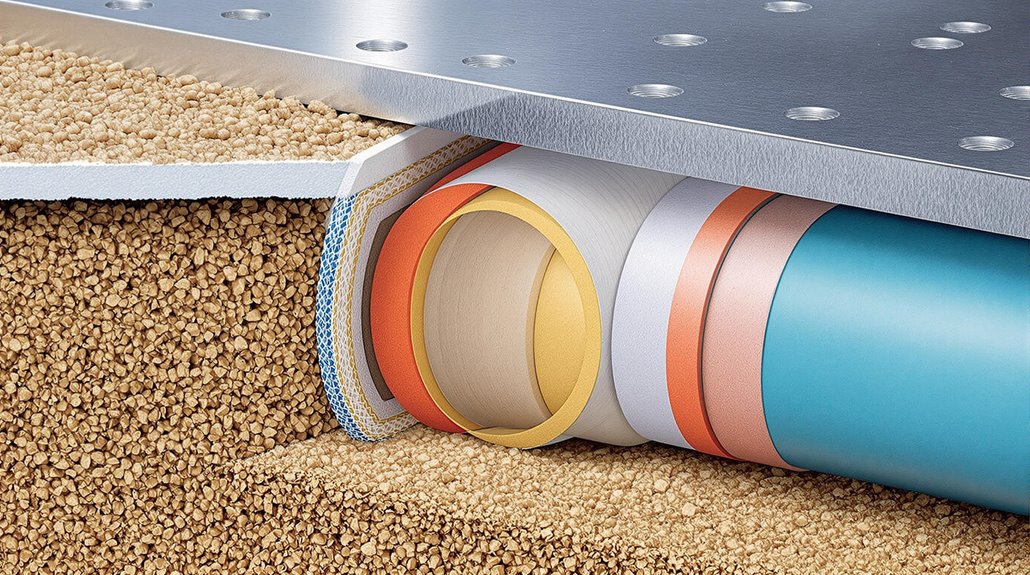
When protecting underground water lines from freezing temperatures, selecting appropriate insulation materials and implementing proven installation techniques becomes essential for long-term system reliability.
Specialty foam pipe wrap designed specifically for underground applications provides ideal thermal protection while maintaining structural integrity over time.
Proper installation requires multiple layers of waterproof insulation to maximize freeze prevention capabilities. The insulation must be carefully wrapped around pipes to create an effective thermal barrier.
For areas with shallow water lines, protective steel plates can be installed above the insulated pipes to prevent damage from surface traffic while maintaining insulating properties.
The selection of appropriate backfill material plays a significant role in the overall insulation system. Sand is particularly effective as it promotes drainage and prevents moisture accumulation around the pipes.
This combination of specialized insulation materials, proper layering techniques, and suitable backfill creates a thorough defense system against freezing in underground water lines.
Heat Cable Solutions and Installation Methods
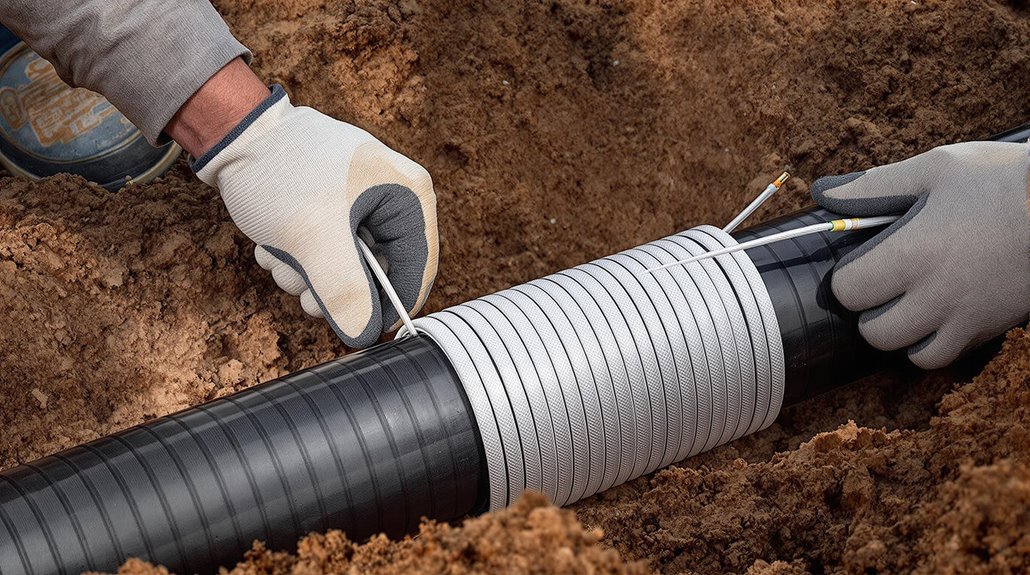
Heat cables provide a reliable defense against frozen pipes when strategically installed alongside proper insulation. Self-regulating models are particularly effective, as they automatically adjust their output based on the pipe's temperature, optimizing energy usage while maintaining consistent protection against freezing.
Installation begins at the pipe ends, with particular attention to vulnerable sections where freezing is most likely to occur. The heat cable must be properly insulated according to manufacturer specifications to guarantee maximum thermal efficiency and durability.
For black poly water pipes, maintaining the recommended wattage of no more than 12 watts per foot is vital for preventing freeze-ups without risking damage to the pipe material.
Regular maintenance and system checks are essential components of an effective heat cable installation. This includes monitoring for proper function and addressing any installation issues promptly to avoid potential freezing and subsequent repairs to the water pipes.
Professional Maintenance and Inspection Guidelines
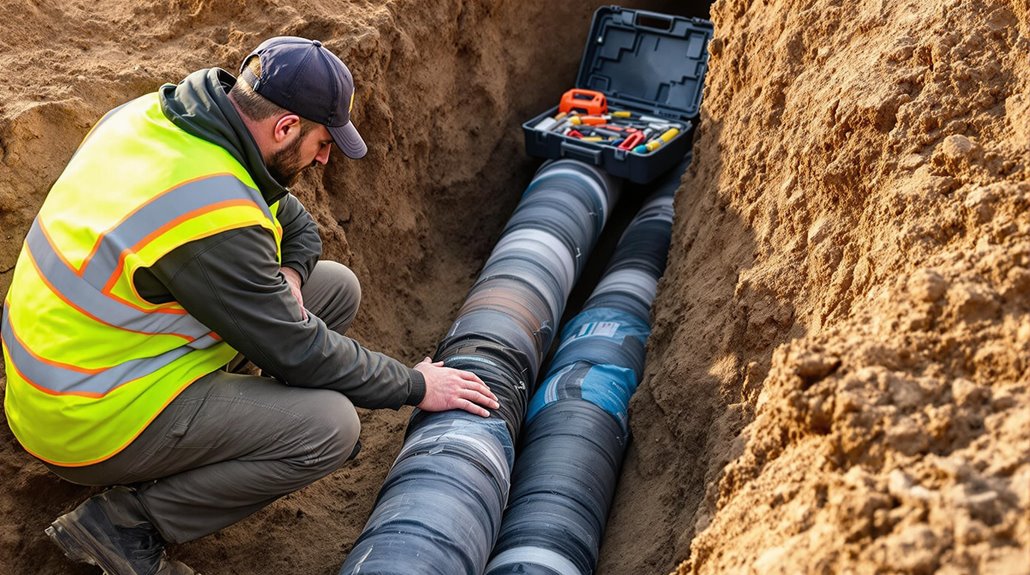
Professional inspections of water lines serve as a critical preventive measure against winter-related pipe damage. Certified technicians conduct thorough assessments to verify that water supply lines are installed below local frost levels and properly protected against freezing temperatures. These evaluations include checking for vulnerabilities in underground plumbing systems and ensuring adequate insulation.
Regular professional maintenance encompasses detailed examinations of foundation seals and crawl spaces to prevent cold air infiltration.
Technicians systematically inspect insulation materials for signs of deterioration or damage that could compromise pipe protection. Based on site-specific conditions and local frost line data, experts develop customized winterization strategies to enhance system resilience.
They identify potential weak points in the underground infrastructure and implement targeted solutions to prevent freeze-related issues. Through extensive inspections, professionals can detect and address early warning signs before they escalate into serious problems, ultimately safeguarding the water supply system throughout winter months.
Preventive Measures for Cold Weather Protection
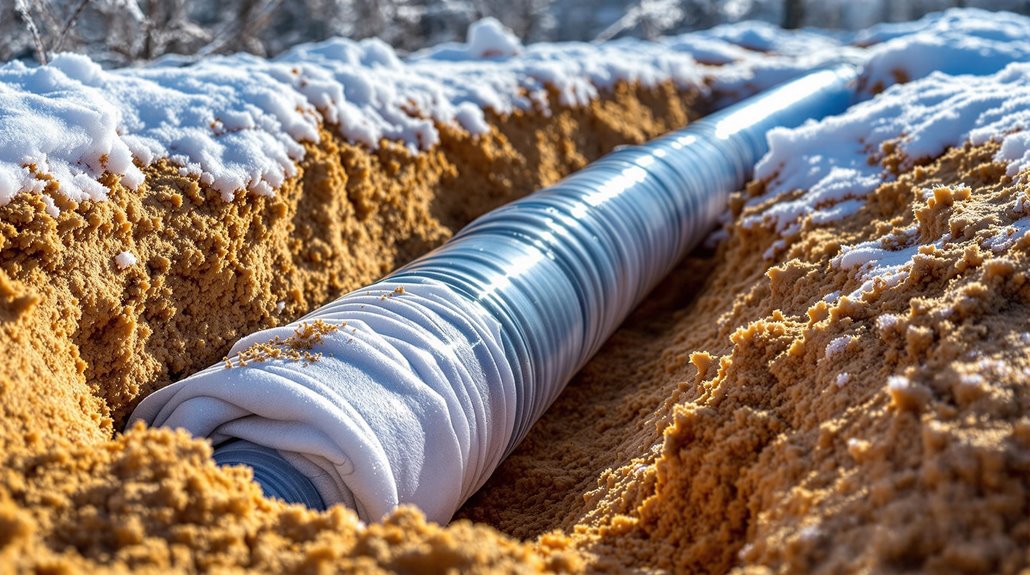
To effectively safeguard water lines against freezing temperatures, implementing extensive preventive measures is essential for maintaining system integrity throughout winter months.
Property owners can prevent their pipes from freezing by ensuring proper insulation with approved specialty materials and waterproofing protection. Installing heat trace cables alongside underground pipes provides vital temperature regulation during extreme cold weather conditions.
Proper burial depth below the frost line serves as a fundamental defense against freezing, and compliance with local regulations regarding installation depths is significant.
Strategic backfilling with insulating materials like sand creates an additional protective barrier that helps maintain consistent temperatures around water lines.
Regular system evaluations enable early detection of potential vulnerabilities in both insulation and heating components, allowing for preventive maintenance before cold weather arrives.
These combined measures create an extensive approach to protecting underground water infrastructure from freeze-related damage, ensuring reliable service throughout winter seasons.
The Benefits Of Consulting A Public Adjuster
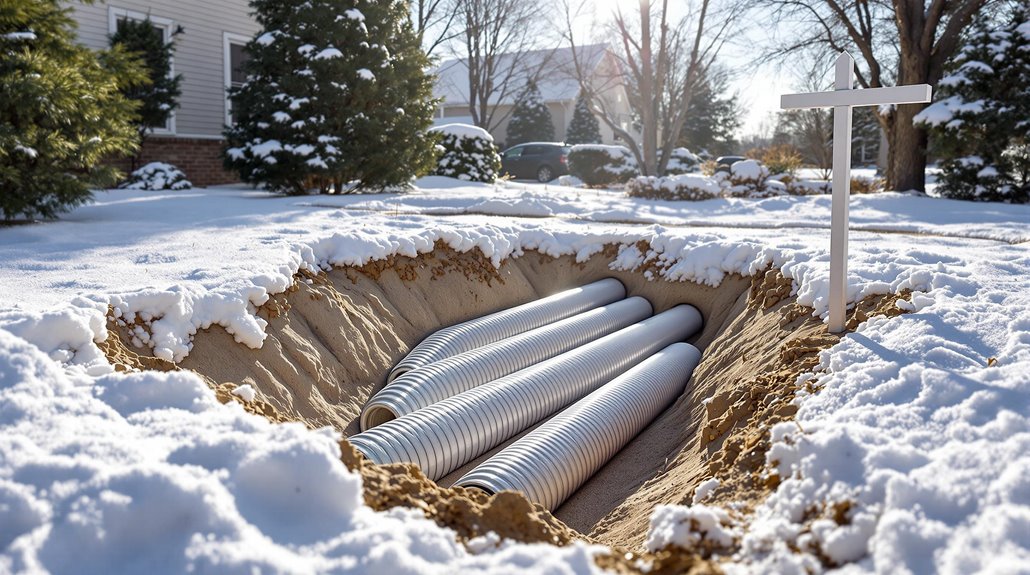
When frozen water lines result in property damage, consulting a licensed public adjuster can provide expertise in documenting and filing insurance claims while ensuring objective damage assessment.
Public adjusters streamline the claims process by professionally evaluating damages, preparing detailed documentation, and negotiating with insurance companies on behalf of property owners.
Statistical evidence shows that policyholders who engage public adjusters typically receive considerably higher claim settlements, with studies indicating increases of up to 800% compared to those handling claims independently.
Expertise In Insurance Claims
Since frozen pipe damage can lead to complex insurance claims, consulting a public adjuster offers significant advantages for homeowners seeking fair compensation.
These professionals possess extensive knowledge of insurance policies and claims procedures, guaranteeing thorough documentation of all damages and losses. Their expertise in negotiation helps maximize settlement amounts while reducing the burden on property owners.
- Skillfully document and present claims to insurance providers
- Navigate complex policy terms and local regulations
- Identify all damages related to frozen pipes, including hidden issues
- Represent homeowner interests throughout the claims process
- Expedite settlements through effective communication with insurers
Public adjusters work exclusively for policyholders, providing dedicated support in achieving ideal claim outcomes.
Their professional understanding of damage assessment and valuation guarantees that homeowners receive appropriate compensation for both immediate and long-term impacts of frozen pipe incidents.
Objective Damage Assessment
Because frozen water line damage often involves complex assessments, public adjusters provide invaluable expertise in evaluating the full scope of property losses. When water line freezes occur, these professionals conduct thorough inspections to identify both obvious and hidden damages that property owners might miss during initial evaluations.
Public adjusters utilize their extensive knowledge of state insurance regulations to guarantee all damages are properly documented and accurately valued. Their objective assessment approach helps maximize claim settlements by presenting detailed evidence to insurance companies.
This expertise is particularly essential for underground water line damage, where complications may not be immediately apparent. By managing the entire claims process, public adjusters save property owners considerable time while guaranteeing a detailed evaluation that accounts for both immediate and potential long-term impacts of freezing damage.
Streamlined Claim Process
Public adjusters not only assess damage but also greatly accelerate the insurance claims process for frozen water line incidents. Working on a contingency basis, these professionals bring valuable expertise to guarantee proper claim documentation and maximize settlement outcomes.
- Expertly navigate complex insurance policies and requirements
- Document damages thoroughly using industry-standard methods
- Connect property owners with qualified contractors and appraisers
- Negotiate directly with insurance companies on behalf of the client
- Provide access to resources that expedite repairs and restoration
Their involvement eliminates the burden of dealing directly with insurance representatives while guaranteeing fair compensation.
Since payment is contingent upon successful settlement, their services remain financially accessible to property owners. This professional support proves particularly valuable during winter emergencies when prompt action is essential for preventing further damage from frozen water lines.
Higher Claim Payouts & Settlements
Most property owners who engage public adjusters experience considerably higher insurance settlements for frozen water line damages. Statistical evidence demonstrates that settlements secured through public adjusters typically range 20-50% above those obtained independently.
This significant increase results from their extensive knowledge of insurance policies and expertise in accurately evaluating property damage.
Public adjusters strengthen claims through meticulous documentation and evidence gathering, substantially reducing the risk of claim denials. Their professional understanding of policy terms and coverage limits enables them to negotiate effectively with insurance companies, ensuring favorable settlement outcomes.
About The Public Claims Adjusters Network (PCAN)
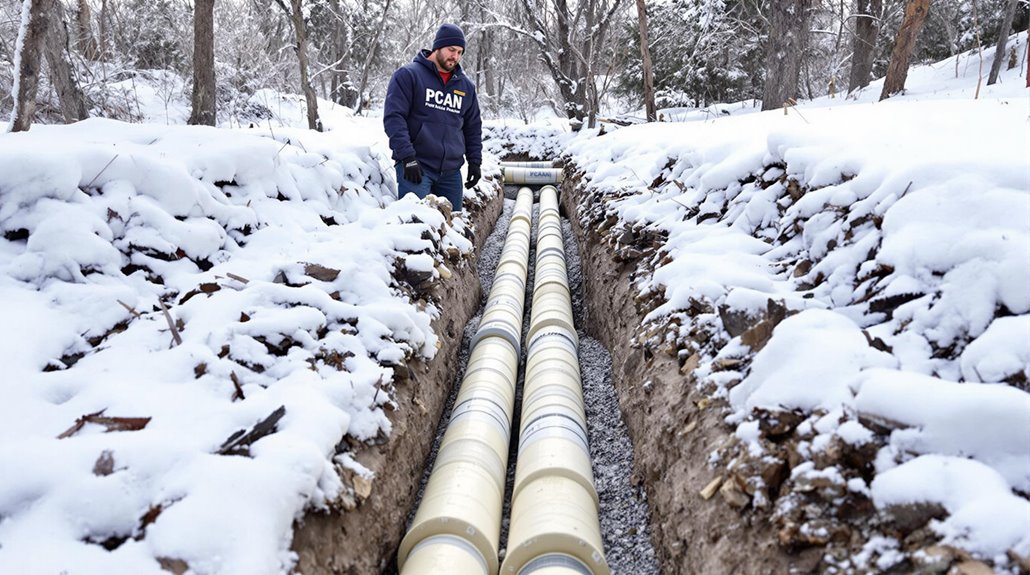
When dealing with frozen water line concerns, homeowners can turn to the Public Claims Adjusters Network (PCAN) for expert assistance.
PCAN is a national organization that connects property owners with pre-vetted, licensed public adjusters who specialize in various types of property damage insurance claims, including water-related damages.
- Operates in over 40 states with coverage for 30+ claim types
- Members undergo intensive vetting and interview processes
- Annual audits guarantee compliance with ethical standards
- All adjusters maintain current state licensing requirements
- Specializes in both residential and commercial property claims
PCAN maintains strict quality control through mandatory yearly reviews of its member adjusters' licenses and complaint records.
This network serves as an essential resource for property owners seeking professional assistance with insurance claims, guaranteeing access to thoroughly vetted experts who understand complex property damage situations.
The organization's commitment to high standards helps protect homeowners during challenging times while facilitating fair claim settlements.
Frequently Asked Questions
How to Keep a Buried Water Line From Freezing?
Like updating your smartphone's software, protecting buried water lines requires proper insulation methods, heat trace installation, winter preparation below frost levels, and specialized materials to prevent frozen pipes.
At What Temperature Do Underground Water Pipes Freeze?
Underground water pipes typically freeze at 20°F (-6°C), but factors affecting freezing include pipe material, soil composition, moisture levels, depth below frost line, and local temperature zones.
How Deep Does a Water Line Need to Be Buried to Keep From Freezing?
Like safeguarding precious artifacts underground, water lines must be buried below the local frost line depth, typically 18-48 inches deep, with proper insulation following regional installation guidelines to prevent freezing.
How to Insulate Water Lines Underground?
Underground water lines require foam insulation and pipe wraps for protection. Heat tape provides supplemental warmth, while maintaining proper soil temperature through adequate depth enhances insulation effectiveness against freezing conditions.
